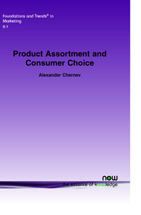Product Assortment and Consumer Choice: An Interdisciplinary Review
By Alexander Chernev, Kellogg School of Management, Northwestern University, USA, ach@northwestern.edu
Abstract
The topic of product assortment has generated a plethora of research across various domains, including economics, analytical and empirical modeling, individual and group decision making, and social psychology. Despite the voluminous assortment research, however, the key findings have remained scattered across domains. In fact, the very domain of assortment research has not been clearly defined, thus complicating the understanding of the current state of assortment research. The goal of this review, therefore, is to define the field of assortment research and outline its key findings. In this context, this review delineates three key domains of assortment research: (1) how consumers perceive the variety of items in an assortment, (2) how consumers choose an item from a given assortment, and (3) how consumers choose among assortments. The key findings in each of these three areas are synthesized in the form of specific research propositions that build on the existing findings and provide guidance for further empirical investigation. By outlining the key findings in each of these three areas, this review offers an integrative framework for understanding the impact of assortment on consumer choice.
Product Assortment and Consumer Choice
Product Assortment and Consumer Choice: An Interdisciplinary Review examines existing literature and builds on the current theoretical developments across different research domains to develop a set of research propositions delineating the impact of product assortment on consumer choice. Taking a consumer's perspective to examine how product assortment influences decision making and choice, this monograph defines the consumer aspect of assortment research to answer three key questions. First, how do consumers perceive the variety of items in an assortment? The first part of this review examines factors that influence consumer perceptions of the variety of an assortment. In particular, it investigates how factors such as assortment size, the degree of distinctiveness of assortment options, the dispersion of option frequencies, and the organization of the assortment influence consumer perceptions of assortment variety. Second, how do consumers choose an item from a given assortment? The second part discusses factors that influence consumer choice of an item from a given assortment. It examines the impact of assortment size on the purchase likelihood from a given assortment, the number of options purchased, and the particular options chosen from the assortment. Third, how do consumers choose among assortments? The third part examines factors that influence consumer choice among assortments. In particular, it investigates how assortment size, assortment structure, and purchase quantity influence consumers' choice of an assortment. Conceptual analysis of the existing research in each of these three areas is summarized in a series of research propositions that integrate current findings and offer directions for future research. Product Assortment and Consumer Choice: An Interdisciplinary Review concludes with a discussion of the theoretical contributions and managerial implications of existing product assortment research and identify venues for further investigation.
